AMD Radeon HD 7990 Review: 7990 Gets Official
by Ryan Smith on April 24, 2013 12:01 AM EST- Posted in
- GPUs
- AMD
- Radeon
- Radeon HD 7000
- Tahiti
Compute
As always we'll start with our DirectCompute game example, Civilization V, which uses DirectCompute to decompress textures on the fly. Civ V includes a sub-benchmark that exclusively tests the speed of their texture decompression algorithm by repeatedly decompressing the textures required for one of the game’s leader scenes. While DirectCompute is used in many games, this is one of the only games with a benchmark that can isolate the use of DirectCompute and its resulting performance.
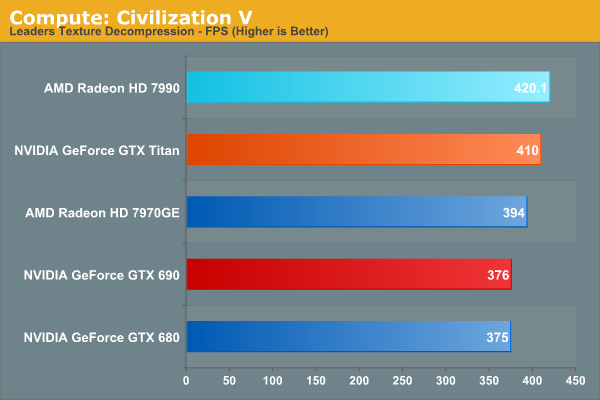
Civ V's texture compression routines are technically mutli-GPU capable, but multi-GPU scaling has never been particularly impressive here. So this test mostly reinforces what we already know about the Tahiti GPU being very capable in most DirectCompute workloads.
Our next benchmark is LuxMark2.0, the official benchmark of SmallLuxGPU 2.0. SmallLuxGPU is an OpenCL accelerated ray tracer that is part of the larger LuxRender suite. Ray tracing has become a stronghold for GPUs in recent years as ray tracing maps well to GPU pipelines, allowing artists to render scenes much more quickly than with CPUs alone.
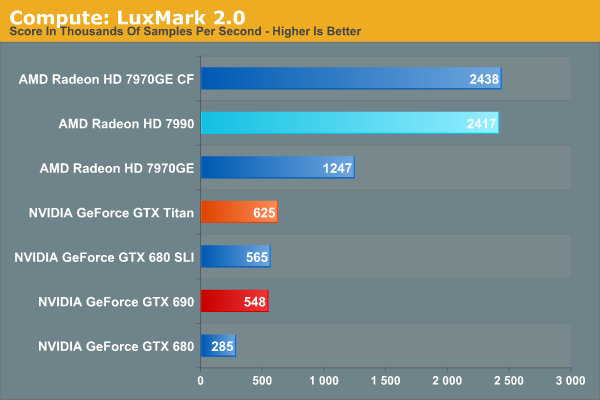
The 7990 isn’t billed as a compute product, but that doesn’t mean it’s at all weak at compute. On the contrary, as LuxMark doesn’t hit the ROPs hard the 7990 has no trouble staying under its 375W target, allowing it to sustain 1000MHz indefinitely. As a result the 7990 takes AMD’s compute advantage and runs with it. The 7990 is a bit more 2x the cost of a 680, but it’s 8.5x faster. Even against GTX Titan the difference is just short of 4x; NVIDIA simply doesn’t do well in our OpenCL tests.
Our 3rd benchmark set comes from CLBenchmark 1.1. CLBenchmark contains a number of subtests; we’re focusing on the most practical of them, the computer vision test and the fluid simulation test. The former being a useful proxy for computer imaging tasks where systems are required to parse images and identify features (e.g. humans), while fluid simulations are common in professional graphics work and games alike.
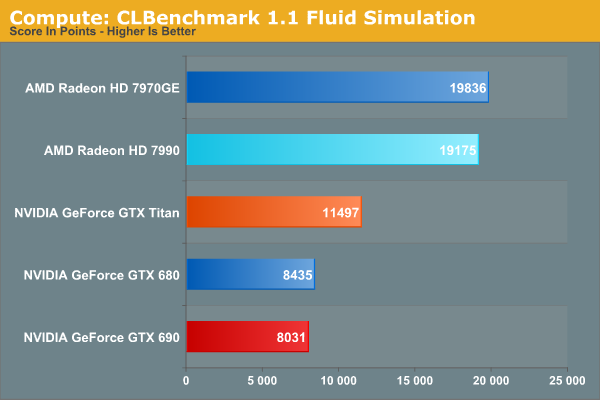
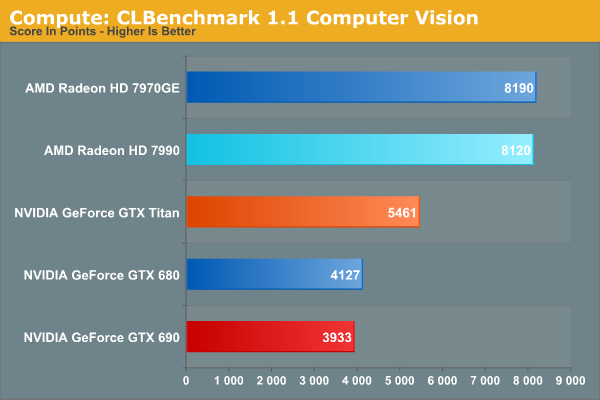
These two CLBenchmark sub-tests aren’t multi-GPU capable, so the performance of the 7990 is essentially dictated by its first GPU. All that means however is that the 7990 is once again at the top of the charts, well ahead of NVIIDA’s other cards and beating Titan by 50%-100%. At the same time this is a good reminder that not every compute task scales well across multiple GPUs, which is why single-GPU products still have a strong place in the GPU compute world.
Moving on, our 4th compute benchmark is FAHBench, the official Folding @ Home benchmark. Folding @ Home is the popular Stanford-backed research and distributed computing initiative that has work distributed to millions of volunteer computers over the internet, each of which is responsible for a tiny slice of a protein folding simulation. FAHBench can test both single precision and double precision floating point performance, with single precision being the most useful metric for most consumer cards due to their low double precision performance. Each precision has two modes, explicit and implicit, the difference being whether water atoms are included in the simulation, which adds quite a bit of work and overhead. This is another OpenCL test, as Folding @ Home is moving exclusively OpenCL this year with FAHCore 17.
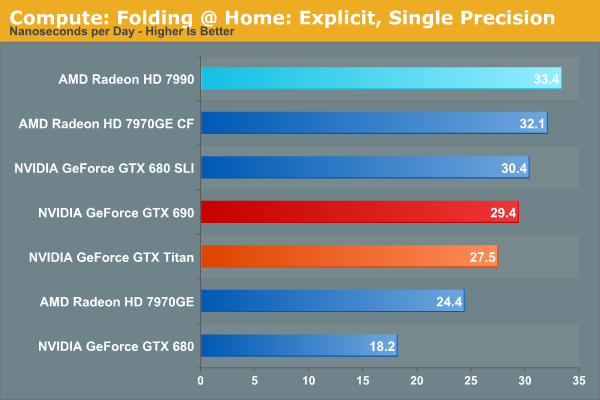
Only FAHBench’s explicit mode is multi-GPU capable, and even then the scaling to multiple GPUs isn’t great. Still, it’s enough to help the 7990 take the top spot on this benchmark, even with NVIDIA’s latest drivers slightly closing the gap. What’s particularly interesting here though is that the 7990 is faster than the 7970GE CF, and that’s not a fluke in our results. The 7990 should by all means be at least a bit slower, and more if throttling kicks in. It looks like we’re seeing one of those rare cases where the GPUs are benefitting from the presence of the PLX bridge, as going through the relatively close-by bridge is faster than in a two-card setup where the GPUs would have to communicate through the CPU/Northbridge. However this is the only time we see such an advantage; in most other compute scenarios – let alone gaming – the PLX bridge won’t have any kind of notable impact.
Wrapping things up, our final compute benchmark is an in-house project developed by our very own Dr. Ian Cutress. SystemCompute is our first C++ AMP benchmark, utilizing Microsoft’s simple C++ extensions to allow the easy use of GPU computing in C++ programs. SystemCompute in turn is a collection of benchmarks for several different fundamental compute algorithms, as described in this previous article, with the final score represented in points. DirectCompute is the compute backend for C++ AMP on Windows, so this forms our other DirectCompute test.
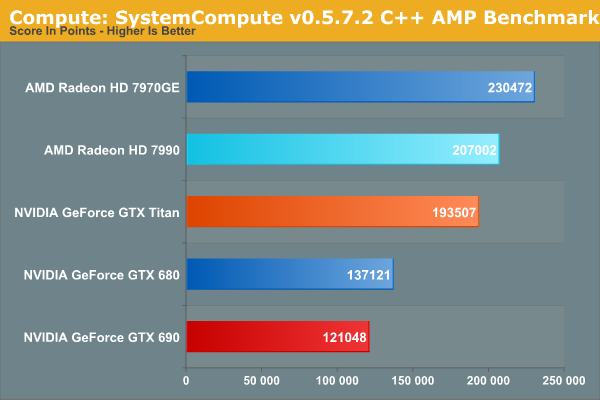
SystemCompute isn’t multi-GPU capable, so once again we’re leaning on the 7990’s first GPU. To that end we find the 7990 in second place, but we also see the 7790 clearly trailing the 7970GE by more than we’ve seen in our other compute benchmarks. SystemCompute does do a lot of I/O, so if FAHBench is the ideal case for showcasing the benefits of the PLX bridge in GPU to GPU I/O, then SystemCompute is good case for showcasing the drawbacks of the PLX bridge, mainly the higher I/O latency. It’s not enough to cripple the 7990 – it’s faster than the GTX Titan even here – but it does cost the 7990 some performance.










91 Comments
View All Comments
Nfarce - Wednesday, April 24, 2013 - link
Most people can't afford to pay $2k in cash (or would not choose to do so if they could do so, as is the case of me). Plunking down that kind of money for GPU performance for gaming and not thinking twice about it (or missing it) is the exception, not the rule. That's all I'm saying. More power to you, so to speak, for bragging rights.Shark321 - Wednesday, April 24, 2013 - link
Without FCAT numbers this review is a complete waste of time. 3 Weeks ago Ryan wrote that FCAT numbers for crossfire will be available "next monday", and nothing has happened since. EVERY other major hardware review website has FCAT results.brucek2 - Wednesday, April 24, 2013 - link
Long time AnandTech fan here, but this review really drops the ball.Like many other commenters said, if you don't have the FCAT analysis or similar, you're not ready to publish a review. As other sites are showing the 7990's frate rate is in some cases largely fictitious and has gamer-perceptible stutter. Apparently the prototype drivers will fix or improve the issue, but the release date is only "second half 2013" ie potentially months away.
Also, did your sample not have the high pitch whine caused by vibrations of the capcitors / PCB that other reviews are reporting? Can't cover what didn't happen but this appears to be a material issue with this card.
In short had I bought this case based solely on this review, I would have ended up sorely dissappointed. I trust AnandTech more than that and don't want to see this trust erode.
HisDivineOrder - Wednesday, April 24, 2013 - link
You have to hand it to AMD. Looking at the benchmark games, six out of ten are already Gaming Evolved titles that were included in a bundle by AMD. Of the four that are not, Battlefield 3 will almost certainly be updated to BF4 this year when the Gaming Evolved version shows up.Control the way the benchmark games are developed, control the benchmarks, and look better by comparison. It's smart and I bet it costs a lot less money than actually releasing new cards every year.
7Enigma - Friday, April 26, 2013 - link
Here's a thought Ryan; You didn't have enough time to get the FCAT results together, and you are releasing a review of a product that at best is 2 weeks away (can you say SUPER SOFT LAUNCH). So how's about you HOLD THE REVIEW until release or at least until you have a proper review ready.The last couple years has seen Anandtech flip/flop constantly on this point. And while I don't feel Anandtech is biased towards one or the other be it AMD/Intel or AMD/NVIDIA, it just looks bad when one time you hold a review and other times incomplete articles get thrown out to beat the NDA....
Chaser - Friday, April 26, 2013 - link
When I decide I need three 30 inch monitors I'll consider a $1000.00 video card. Meh.Mr. Mephisto - Monday, April 29, 2013 - link
i currently own the powercolor 7990 and i have to say the driver releases have changed the performance exponentially. the card was downright disappointing playing crysis 3 using driver 13.2 but after 13.5 there is a much smoother gaming experience. i really dont think that it matters if AMD has better architecture if they cant release good drivers.*i guess it should be said that this is my first AMD card in my 7-8 years of gaming. i used to be a nvidia fanboy XD
Parablooper - Monday, April 29, 2013 - link
There's no way I can afford it, but that doesn't stop me from getting really fucking pumped.Biln3 - Tuesday, April 30, 2013 - link
looks like we need to buy 2 6970s instead of a 6990Shark321 - Friday, May 3, 2013 - link
There is a rumour floating around in forums that Anandtech did not post any FCAT results (like promised 4 weeks ago), because of a deal with AMD.